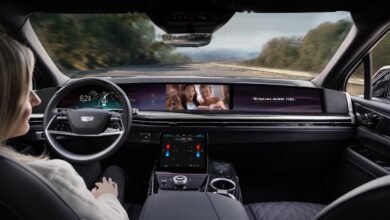GM’s Escalade IQ to Offer Hands-Free Driving by 2028

▼ Summary
– GM is shifting focus to autonomous driving, AI, and software-defined vehicles despite recent EV production setbacks and a $1.6 billion loss from reduced federal tax credits.
– The company plans to introduce a Level 3 hands-free highway driving feature in the Cadillac Escalade IQ by 2028, building on its Super Cruise technology with 600,000 miles of mapped highways.
– GM will integrate Google’s Gemini AI as a voice assistant starting next year and later develop its own AI companion tailored to vehicle intelligence and user preferences.
– A new centralized computing platform will launch in 2028, offering enhanced over-the-air updates, bandwidth, and AI performance for both EVs and internal combustion vehicles.
– GM is advancing robotics for manufacturing with autonomous and collaborative robots and launching a program for EV owners to send battery power back to the grid through its GM Energy Home System.
Despite recent adjustments to its electric vehicle production strategy, General Motors is making a bold statement about its technological future, announcing a suite of advanced features for its Cadillac and Chevy brands. CEO Mary Barra positioned these innovations as central to defining the company’s next chapter, even as GM navigates a significant financial setback. The automaker recently reported a $1.6 billion loss tied to its EV rollout, a figure largely influenced by the expiration of the $7,500 federal EV tax credit. Industry analysts warn this could depress electric vehicle sales, potentially weakening America’s competitive stance in the global automotive sector. In response, GM is pivoting attention toward autonomous driving, artificial intelligence, and sophisticated software as key areas where the U.S. can maintain a leadership position, particularly against rapid advancements from Chinese manufacturers.
A headline announcement involves the planned introduction of a Level 3 hands-free highway driving system for the Cadillac Escalade IQ, slated for a 2028 debut. This marks a significant step beyond the company’s existing Super Cruise, a Level 2 system launched in 2017. The new technology will be operational across a 600,000-mile mapped highway network and will be supported by advanced perception and decision-making capabilities. According to the Society of Automotive Engineers (SAE), Level 3 automation allows drivers to take their eyes off the road in specific scenarios, though they must remain prepared to resume control when prompted. It is important to note this is not full self-driving; such systems typically function at reduced speeds on pre-mapped roads. Some safety advocates have expressed concerns about Level 3, citing the potential danger of drivers becoming inattentive while the vehicle handles most driving tasks.
In a recent podcast interview, GM’s Chief Product Officer, Sterling Anderson, emphasized that safety remains the paramount concern for the Level 3 rollout. He pointed to the company’s track record with Super Cruise as evidence of its commitment. Anderson, who previously led Tesla’s Autopilot program, stated that GM’s hands-free technology sets an industry benchmark for safety. “Our customers have driven over 700 million hands-free miles with Super Cruise without a single accident attributed to the technology,” he noted, adding a pointed comparison: “I led Autopilot. You can’t say that for Autopilot.”
Voice assistance is also getting a major upgrade. Starting next year, GM vehicles will incorporate Google’s Gemini AI to provide a more natural, conversational interface. While other manufacturers like Volvo are pursuing similar integrations, GM plans to eventually introduce its own proprietary AI assistant, designed to be finely attuned to individual vehicle data and driver preferences. Anderson explained that this system will understand context, allowing drivers to ask about destinations and receive intelligent, relevant responses.
On the hardware front, GM is preparing to launch a revolutionary centralized computing platform in 2028, with the Escalade IQ again serving as the launch vehicle. The company describes this as a complete overhaul of vehicle architecture, promising a tenfold increase in over-the-air update capacity, a thousandfold boost in bandwidth, and up to thirty-five times more AI processing power for autonomous and advanced features. This new platform will be deployed across GM’s entire lineup, including both electric and internal combustion engine models. Anderson provided technical details, highlighting a shift to Ethernet-based networking that enables sub-millisecond response times. This represents a tenfold improvement over previous systems, creating what he called a “massive opportunity” for both vehicle dynamics and the sophistication of deployable software.
GM’s ambitions extend beyond the consumer vehicle. The company provided an update on its robotics division, which employs a team of 100 specialists focused on developing advanced systems to enhance manufacturing. These factory robots are being trained using vast amounts of production data, telemetry, quality metrics, and sensor information, to create models that improve with every manufacturing cycle. Work is underway at GM’s Autonomous Robotics Center in Warren, Michigan, and a companion lab in Mountain View, California, with the company actively hiring for roles like electrical systems architect and validation engineer.
Anderson shared that GM currently operates approximately 30,000 robots alongside 97,000 production staff across 11 facilities. Many of these are traditional industrial arms confined to safety cages, unable to work safely near people. The next generation of GM robotics looks very different. The company is now deploying autonomous mobile robots to transport materials through factories and is developing collaborative robots, or “cobots,” designed to work directly alongside human employees.
Finally, GM is launching a new program to enable vehicle-to-grid (V2G) technology, allowing electric vehicle owners to send stored battery power back to the electrical grid. This capability has been part of GM Energy’s portfolio since its 2022 launch. While many EVs with large batteries can provide backup power during an outage, this new initiative will also support feeding electricity to the grid during periods of high demand. Starting next year, GM will offer a new leasing model for its integrated GM Energy Home System, which combines backup power, solar integration, and a unified application for complete control.
(Source: The Verge)





